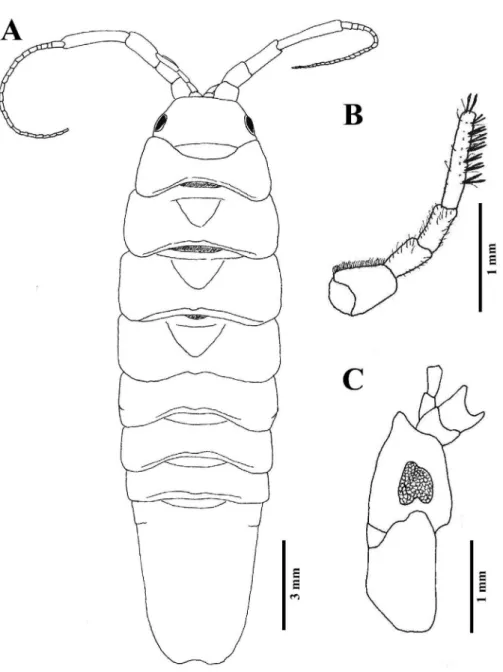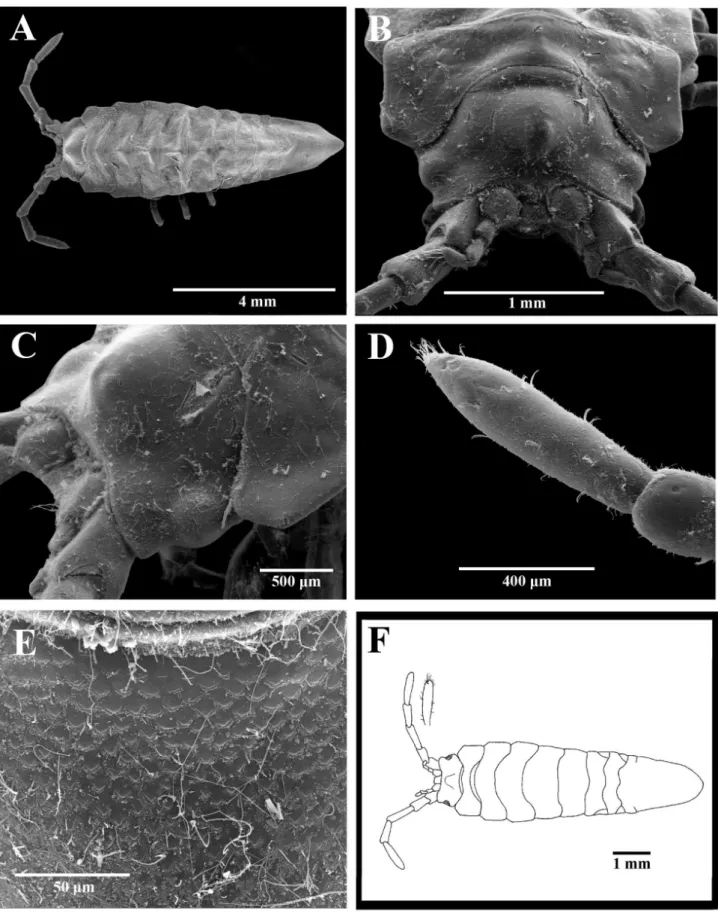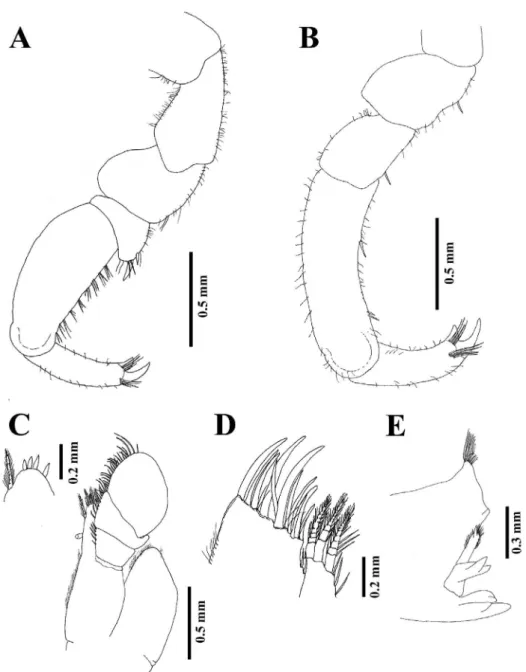Nauplius
THE JOURNAL OF THE
BRAZILIAN CRUSTACEAN SOCIETY
e-ISSN 2358-2936 www.scielo.br/nau www.crustacea.org.br
Notes on two shallow water isopods
(Crustacea: Peracarida: Isopoda:
Idoteidae) from Kino Bay, Gulf of
California, Mexico
Michel E. Hendrickx
Laboratorio de Invertebrados Bentónicos, Unidad Académica Mazatlán, Instituto de Ciencias del Mar y Limnología, Universidad Nacional Autónoma de México. P.O. Box 811. Mazatlán, 82000, Sinaloa, Mexico.
ZOOBANK:
http://zoobank.org/urn:lsid:zoobank.org:pub:8F24473C-37F9-46D0-8275-4200B8F9C387
ABSTRACT
Two species of isopods of the family Idoteidae were collected in the same sample, among sea grasses, in the northern Gulf of California, Mexico. The first species, Synidotea harfordi Benedict, 1897, was more abundant (46 specimens) than the second species, Eusymmerus antennatus Richardson, 1899 (eight specimens). Synidotea harfordi has previously been considered uncommon in the Gulf of California, and more like a component of warm-temperate to colder-water fauna. The male of E. antennatus has not been illustrated but SEM photographs are provided and show angular margins of the first three pereonites and a sharply bent lateral margin of the telson. Females also have angular first pereonites. All previous illustrations show rounded pereonites margins. Buccal appendages of E. antennatus are illustrated and compared with previous descriptions.
KEY WORDS
Isopoda, western Mexico, sea grasses.
Isopods are common inhabitants of marine vegetation, including algae and sea grasses, which they use as shelter and food (Boström and Mattila, 1999; 2005). They play an important role in fragmentation of vegetation and its incorporation into the trophic webs (Robertson and Mann, 1980). Idoteidae are also important prey of larger predators such as fishes (Wallerstein and Brusca, 1982).
Idoteidae of the Gulf of California were reviewed by Brusca and Wallerstein (1977) who listed eight species in four genera. Two years later, the same authors reported a total of 11 species and proposed a key to the species known from the Gulf of California (Brusca and Wallerstein, 1979). Espinosa-Pérez and Hendrickx (2001) included 13 species of Idoteidae for the entire tropical eastern Pacific (western Mexico to northern Peru). Of these, all, except Edotia sublittoralis Menzies and Barnard, 1959, have been recorded in the Gulf of California at that time. More recently, Brusca et al.
CORRESPONDING AUTHOR
Michel E. Hendrickx
michel@ola.icmyl.unam.mx SUBMITTED 09 March 2018
ACCEPTED 29 June 2018
PUBLISHED 03 December 2018
DOI 10.1590/2358-2936e2018027
All content of the journal, except where identified, is licensed under a Creative Commons attribution-type BY.
(2005) reported 13 species from the Gulf of California including a 13th species, Idotea metallica Bosc, 1802, which has not been reported in previous compilations.
During sampling in Kino Bay, in the northern Gulf of California, many crustaceans were collected among sea grasses. This material included two species of Idoteidae which are reported here.
MATERIAL AND METHODS
Specimens were collected with a dredge ca. 40 cm wide and 15 cm high, at depths of ~0.5−1.2 m, on the protected side of Alcatraz Island, Kino Bay. The dredge was fitted with a 0.5 cm mesh size net. The material was
preserved in the field in a mild formaldehyde solution, later washed with sea water and conserved in 70% ethanol. In the laboratory, isopods were separated, identified, assigned a catalogue number, and kept in the holdings of the Regional Collection of Marine Invertebrates (ICML-EMU) in Mazatlán, Mexico. Measurements (total length) were obtained to the nearest 0.1 mm. Abbreviation: TL, total length.
RESULTS AND DISCUSSION
Idoteidae Samouelle, 1819
Synidotea harfordi Benedict, 1897 (Fig. 1)
Idotaea marmorata Harford, 1877: 117.
Synidotea harfordi Benedict, 1897: 402, fig. 13. — Richardson, 1899a: 849. —Richardson, 1899b: 269. —Richardson, 1905: 387–388, figs. 427–428. — Johnson and Snook, 1927: 290. — Schultz, 1969: 67. — Menzies and Miller, 1972: 16–18, fig. 6. — Brusca and Wallerstein, 1979: 260–261, fig. 3, 269 (key). — Austin, 1985: 581. —Espinosa-Pérez, 1999: 156. — Espinosa-Pérez and Hendrickx, 2001: 50 (list). — Espinosa-Pérez and Hendrickx, 2006: 242. — Brusca et al., 2001: 31 (list), fig. 91. — Brusca et al., 2005: 137 (list).
Synidotea hartfordi. — Wallerstein, 1980: 338. — Vargas et al., 1985: 234.
Material examined. Alcatraz Island, Kino Bay
(28°48’56”N 111°57’51”W), Sonora, Mexico, 25 males (TL 7.8–20.6 mm) and 21 ovigerous females (TL 11.1-13.3 mm), 8 March 2007, 0.5–1.2 m depth, among sea grasses (ICML-EMU-12093).
Distribution. Magdalena Bay (type locality). Oregon and Morro Bay, California, USA. Cedros Island, Baja California, Mexico. Gulf of California, Mexico: Chivato Point, near Santa Rosalia, Baja California Sur; Estero del Soldado, Guaymas, and Bacochibampo, Sonora; Chamela, Jalisco; Acapulco, Guerrero. Gulf of Nicoya, Costa Rica (a single record). Introduced in Japan (Richardson, 1905; Menzies and Miller, 1972; Brusca and Walerstein, 1979; Vargas et al., 1985; Espinosa-Pérez, 1999; Brusca et al., 2001, 2005).
Remarks. The illustration by Richardson (1905;
dorsal view and maxilliped) was of poor quality. Menzies and Miller (1972) provided a detailed series of illustrations of S. harfordi, including a dorsal view, and figures of pereopods 1 and 7, buccal appendages (mandible, maxilla 1 and 2, maxilliped), appendix masculina, and pleopods 1 and 2. Other illustrations were provided by Brusca and Wallerstein (1979, dorsal view and maxilla 2), and Brusca et al. (2001; dorsal view), but were not very detailed.
The material examined herein (Fig. 1) fits well the description of Menzies and Miller (1972). Pairs of setae illustrated on the last antenna 1 article (Fig. 1B) by these authors are aesthetascs. With a total of 46 specimens collected in a single seagrass sample during this study, S. harfordi does not appear to be
as uncommon as previously reported for the Gulf of California (Brusca & Wallerstein, 1979), at least in its northern part. Males and females were found in roughly the same number, and all females were ovigerous. Menzies and Miller (1972) emphasize that the thermal distribution of S. harfordi ranges from warm-temperate to colder waters at 34°30’N. Therefore, the presence of this species in Kino Bay, where shallow-water summer temperatures can be in the range of 25−30°C, is noteworthy.
Eusymmerus antennatusRichardson, 1899
(Figs. 2, 3)
Eusymmerus antennatus Richardson, 1899a: 852–853, figs. 26–27. — Richardson, 1989b: 273; Richardson, 1905: 399–400, figs. 445–446. — Schultz, 1969: 83, fig. 108. — Brusca and Wallerstein, 1977: 7, figs. 4, 5; — Brusca and Wallerstein, 1979: 269 (key). — Brusca, 1980: 237, fig. 12.27. — Vargas et al., 1985: 338. — Calderon-Aguilera and Campoy-Favela, 1993: 418. — Espinosa-Pérez and Hendrickx, 2001: 50 (list). — Espinosa-Pérez and Hendrickx, 2006: 241. — Brusca et al., 2005: 136.
Material examined. Alcatraz Island, Kino Bay
(28°48’56”N 111°57’51”W), Sonora, Mexico, Sonora, Mexico, 5 males (TL 7.8–13.8 mm) and 3 ovigerous females (TL 8.6–9.3 mm), 8 March 2007, 0.5–1.2 m depth, among sea grasses (ICML-EMU-12092).
Distribution. Abreojos Point (type locality) and Eugenio Point, west coast of Baja California Sur; Puerto Peñasco, Algodones Bay and San Francisco Bay, Sonora; Mazatlán, Sinaloa; Sayulita and Raza Point, Nayarit; Chamela Bay, Jalisco; Santa Lucia Bay, Acapulco, Guerrero; and Salina Cruz, Oaxaca, Mexico. Gulf of Nicoya, Costa Rica (Richardson, 1905; Brusca and Wallerstein, 1977; Espinosa-Pérez, 1999; Brusca
et al., 2005).
the single specimen available. Brusca and Walerstein (1977) redescribed E. antennatus in details (female: dorsal view; antenna and antennula; pereiopods 1 and 5; maxilliped, maxilla 1 and 2, mandible; pleopods 1–5; uropods) since Richardson (1899a, 1899b, 1905) had not illustrated properly the appendages of this species. The dorsal figure of the female specimen in Brusca and Wallerstein (1977), later reproduced by Brusca (1980), is quite different from the illustration of Richardson (1899a, 1905) in that it is narrower, eyes are located dorso-laterally (instead of dorsally), it features a medial dorsal tubercle (not illustrated or
about 2/3 of its length (Fig. 2A), which is different from what is observed in females: lateral margins “tapering posteriorly to a rounded apex” (Brusca and Wallerstein, 1977). Females collected in Kino Bay (Fig. 2F) are also much narrower than previously illustrated. Pereiopods 1 and 3 of the Kino Bay specimens are similar (Fig. 3A, B) to those illustrated by Brusca and Wallerstein (1977), with bifid dactyls and with robust and weaker spines on the inner margin of the carpus of pereiopod 1. Distal article of antenna 1 (Fig. 2D) bears short, isolated setae and a tuft of terminal setae, as illustrated by Brusca & Wallerstein (1977). Tergites of pereonites are covered with minute scales (Fig. 2E), not reported previously for this species.
The buccal appendages (Fig. 3) fit well the redescription of E. antennatus by Brusca and Wallerstein (1977), although some small differences were observed. Maxilliped (Fig. 3 C) features a 4-segment setose palp and the endite is similar to that described by Brusca and Wallerstein (1977), with one short coupling hook, but terminal setae have pseudo-articulations. Maxilla 1 exopod has a similar number of large apical spines but these appear proportionally longer in the Kino material (Fig. 3D), and the endopod ends in 3 (instead of 2) “setose spines” which are actually plumose setae with pseudo-articulations (Fig. 3D). The left mandible is similar to the description provided by Brusca and Wallerstein (1977), including the additional 3-pointed “setose spine” between the incisor and the lacina mobilis (Fig. 3E).
The discovery of sympatric, reproducing populations of S. harfordi and E. antennatus in a coastal ecosystem in the northern Gulf of California brings additional information on the general distribution and abundance of these two species in the eastern Pacific.
ACKNOWLEDGMENTS
Thanks to Philippe Willenz for his invitation and to Julien Cillis, SEM service, Institut Royal des Sciences Naturelles de Belgique, for taking and processing the SEM photographs of figure 2. The author also thanks Mercedes Cordero Ruiz for editing figures 1–3.
REFERENCES
Austin, W.C. 1985. An annotated checklist of marine invertebrates in the cold temperate northeast Pacific. Khoyatan Marine Laboratory, Cowichan Bay, Canada, 682p.
Benedict E.J. 1897. A revision of the genus Synidotea. Proceedings of the Academy of Natural Sciences of Philadelphia, 49: 389–404.
Boström, C. and Mattila, J. 1999. The relative importance of food and shelter for seagrass-associated invertebrates: a latitudinal comparison of habitat choice by isopod grazers. Oecologia, 120: 162–170.
Boström, C. and Mattila, J. 2005. Effects of isopod grazing: an experimental comparison in temperate (Idotea balthica, Baltic Sea, Finland) and subtropical (Erichsonella attenuata, Gulf of Mexico, USA) ecosystems. Crustaceana, 78: 185–200.
Brusca, R. C., 1980. Common Invertebrates of the Gulf of California, 2nd ed. The University of Arizona Press, Tucson,
AZ, USA, 513p.
Brusca, R. C. and Wallerstein, B.R. 1977. The Marine Isopod Crustacea of the Gulf of California: I. Family Idoteidae.
American Museum Novitates, 2634: 1–17.
Brusca, R.C. and Wallerstein, B.R. 1979. The marine isopod crustaceans of the Gulf of California. 1. Idoteidae: new genus and species, range extensions, and comments on evolution and taxonomy within the family. Proceedings of the Biological Society of Washington, 92: 253–271.
Brusca, R.C.; Coelho, V.R. and Taiti, S. 2001. A guide to the coastal isopods of California. http://tolweb.org/notes/?note_ id=3004
Brusca, R.C.; Wetzer, R.; Espinosa-Perez, Ma.C. and Hendrickx, M.E. 2005. Cap. 11. Crustacea 3. Peracarida: Isopoda. p. 131–137. In:M.E. Hendrickx, R.C. Brusca and L.T. Findley (eds), A Distributional Checklist of the Macrofauna of the Gulf of California, Mexico. Part I. Invertebrates. [Listado y Distribución de la Macrofauna del Golfo de California, México, Parte I. Invertebrados]. U.S.A., AZ, Arizona-Sonora Desert Museum, 429p.
Calderon-Aguilera, L.E. and Campoy-Favela, J. 1993. Bahía de las Guásimas, Estero los Algodones y Bahía de Lobos, Sonora. p. 411–419. In:S.I. Salazar-Vallejo and N.E. González (eds.), Biodiversidad Marina y Costera de México. Mexico, Comisión Nacional para el Conocimiento de la Biodiversidad and CIQRO, 865p.
Espinosa-Pérez, M.C, 1999. Taxonomía y afinidades biogeográficas de los isópodos (Crustacea: Peracarida: Isopoda) del Pacífico mexicano. Universidad Nacional Autónoma de México, Postgrado en Ciencias del Mar y Limnología, Mexico. M. Sc. Thesis, 231p.
Espinosa-Pérez, M.C. and Hendrickx, M. E. 2001. Checklist of isopods (Crustacea: Peracarida: Isopoda) from the eastern tropical Pacific. Belgian Journal of Zoology, 131: 43–56.
Espinosa-Pérez, M.C. and M.E. Hendrickx. 2006. A comparative analysis of biodiversity and distribution of shallow-water marine isopods (Crustacea: Isopoda) from polar and temperate waters in the East Pacific. Belgian Journal of Zoology, 136: 219–247.
Johnson, M.E. and H.J. Snook. 1927. Seashore animals of the Pacific coast. New York, Macmillan Company, 659p.
Menzies, R.J. and M.A. Miller. 1972. Systematics and zoogeography of the genus Synidotea (Crustacea: Isopoda) with an account of Californian species. Smithsonian Contributions to Zoology, 102: 1–33.
Poore, G.C.B. 1996. Species differentiation in Synidotea (Isopoda: Idoteidae) and recognition of introduced marine species: a reply to Chapman and Carlston. Journal of Crustacean Biology, 16: 384–394.
Richardson, H. 1899a. Key to the isopods of the Pacific coast of North America, with descriptions of twenty-two new species.
Proceedings of the United States National Museum, 21: 815–869.
Richardson, H. 1899b. Key to the isopods of the Pacific coast of North America, with descriptions of twenty-two new species.
Annals and Magazine of Natural History, series 7, 4: 157–187, 260–277, 312–338.
Richardson, H. 1905. A monograph on the isopods of North America. U.S. National Museum Bulletin, 54: 1–727.
Robertson, A. I. and Mann, K. H. 1980. The role of isopods and amphipods in the initial fragmentation of eelgrass detritus in Nova Scotia, Canada. Marine Biology, 59: 63–69.
Samouelle, G. 1819 The entomologists’ useful compendium; or an introduction to the knowledge of British Insects, comprising
the best means of obtaining and preserving them, and a description of the apparatus generally used; together with the genera of Linné, and modern methods of arranging the Classes Crustacea, Myriapoda, spiders, mites and insects, from their affinities and structure, according to the views of Dr. Leach. Also an explanation of the terms used in entomology; a calendar of the times of appearance and usual situations of near 3,000 species of British Insects; with instructions for collecting and fitting up objects for the microscope. London, Thomas Boys, 496p.
Shultz, G.A. 1969. How to know the marine isopod crustaceans. Dubuque, U.S.A., Wm. C. Brown Company Publishers, 359p.
Vargas, A.J.; Dean, H.K.; Maurer, D. and P. Orellana. 1985. Lista preliminar de invertebrados asociados a los sedimentos del Golfo de Nicoya, Costa Rica. Brenesia, 24: 327–342.
Wallerstein, B.R. 1980. Isopoda. In: A taxonomic listing of common marine invertebrate species from Southern California. D. Straughan and R.W. Klink (eds.). Technical Report of the Allan Hancock Foundation, 3: 230–236.


